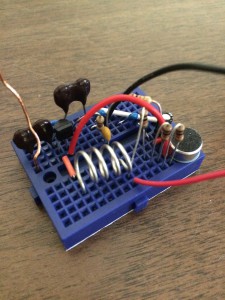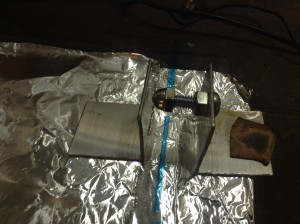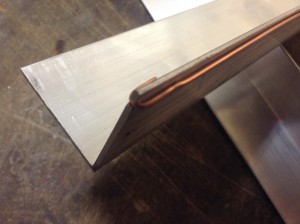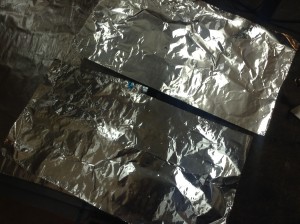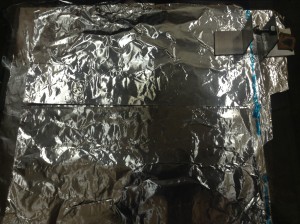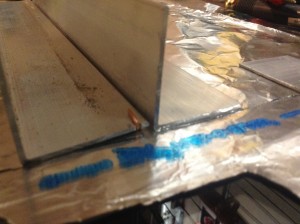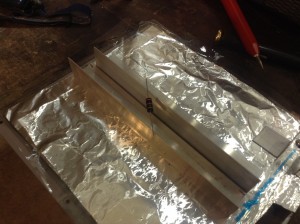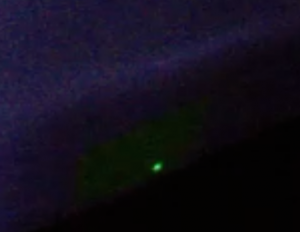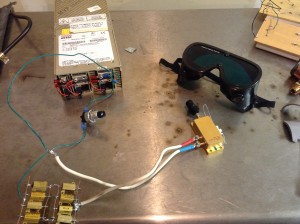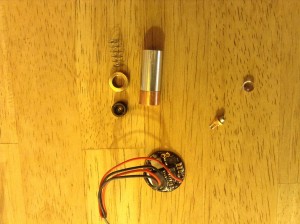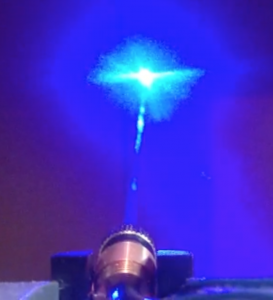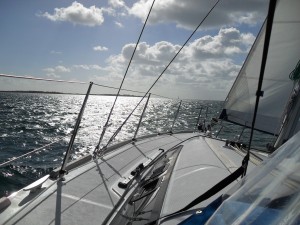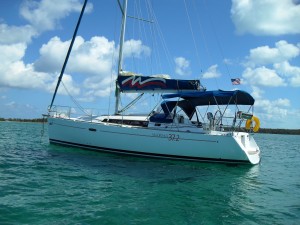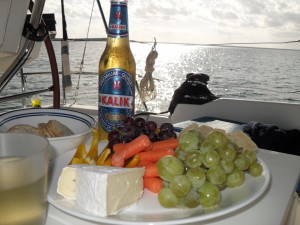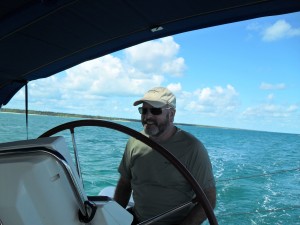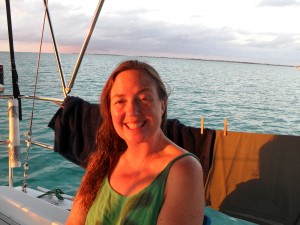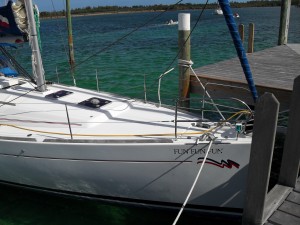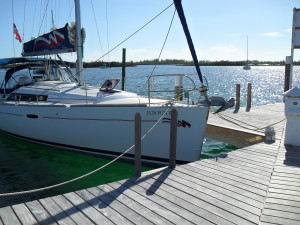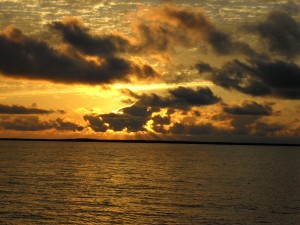Bugsville
FM Transmitter
Ok, a few postings as I have been gone from this blog for a year. Reboot.
Above is a pic of a simple FM transmitter that picks up ambient sound in a room, such as talking, and transmits it at a frequency that can be picked up by any FM radio. Less than 20 simple parts, it works amazingly well for such a simple circuit. It contains one transistor and a microphone I salvaged from an old FRS radio. The silver wire coil is handmade, just a piece of wire coiled around a pen. This is not my invention nor is it anything new, but it is quite an effective short-range transmitter “bug” that I’m sure has been replicated thousands of times by amateur “spies.”
Posted in Electronics and Radios by Mark with comments disabled.
Resurrection
New posts coming. In the meantime, I want to brag that I recently discovered I beat the Equation Group!
Posted in Journal by Mark with comments disabled.
Brainwaves!
trim.2E147C35-49EF-4385-A14F-F5455A3B96BD
Posted in Journal by Mark with comments disabled.
Enough of Walter Kirn!
Ok,
This is a new one for my blog.
I love Terry Gross on NPR. I’ve probably listened to around one thousand interviews she has done and they are the most interesting you can find. Anywhere.
BUT… Her interview of Water Kirn is OVER THE LINE! Who was conned into doing what?
Ok, so this is the story: Walter Kirn, a novelist (who I never heard of but is apparently influential) was fooled into thinking this guy was a wealthy freak. Kirn even said in the interview that everyone was fooled, there were no examples of someone who was not fooled. Seriously?
No, during Gerhartsreiter’s entire life of deception, just about everyone who knew him, including ex-wives, figured out he was a lying freak. Everyone except Kirn, apparently. Read it in wikipedia. Why didn’t Kirn figure this out? Is he one of the few chosen ones who had never seen a con man prior to becoming an adult? Maybe. But now he can write a book about it.
Sorry Terry, you were conned into giving this con man an interview.
Posted in Journal by Mark with comments disabled.
How To Build A Laser
 6500 Volt Spark Gap Flashes Immediately Prior To Laser Firing
6500 Volt Spark Gap Flashes Immediately Prior To Laser Firing
Ok, here is how to build a low cost laser using easy to obtain parts.
This is what you need and where to get it:
- High voltage DC power supply that you can make from a neon sign transformer as described here.
- Three sheets of aluminum foil – grocery store.
- Thin plastic vapor barrier sheet – hardware or flooring store.
- Aluminum right angle bar – hardware store.
- Copper wire – hardware or electronics store.
- A one watt resistor of any value between 10K and 1 meg ohm – electronic parts store.
- 1 inch long bolt – hardware store.
- Nut for above bolt – hardware store.
- Round capnut for above bolt – hardware store.
- Highlighter pen – department store.
- One sheet white paper – duh.
First, you need to cut the aluminum angle bar into several pieces using a hacksaw. The first two pieces should be about a foot long, the next two about an inch long. File down all sharp edges.
Drill a hole in one of the small pieces to put the bolt through. Construct the piece so that it looks like the righthand assembly in the above pic. This will be your spark gap.
With one of the long aluminum angle bars, cut two notches in each end. Stretch the copper wire between the two notches and fold it across them.
The wire should be very straight as shown above. The object is to make physical contact over the entire length of the aluminum bar.
When you are done you the two bars should look as above, one with the copper wire as shown. These two bars will function as the laser electrodes with the laser light being produced between them. Next, you need to construct the laser discharge capacitors. It’s pretty easy to do.
Cut out a big sheet of aluminum foil with a tab on one side as shown below. Pretty much any size will do, a good place to start is one square foot.
Next, cut a square of the thin plastic vapor barrier sheet. This sheet will lay on top of the first square aluminum foil sheet you cut. It should be the thinnest you can buy, probably around 4 mils thick. The plastic sheet should be cut so that it is about a quarter inch larger than the aluminum foil square below it on all sides except for the tab that sticks out to the left.
Next you cut two more aluminum foil sheets of equal size, a little less than half the width of the original sheet of foil as shown above. They will lay on top of the plastic sheet.
Align the two foil sheets so that they are 1/8″ apart lengthwise. The spark gap is shown in the upper righthand corner. One element of the spark gap is contacting one of the top aluminum sheets, the other end is contacting the bottom sheet where the tab protrudes from under the plastic sheet.
Next, you must place the two aluminum bars along the edges of the top foil sheets as shown above. Note that the copper wire must be in contact with one of the foil sheets and the other bar is simply sitting on the edge of a sheet. There should be a gap of one millimeter. This is easy to gauge, it is about the thickness of the wire on your one watt resistor. Make sure the gap between the bars is as consistent along the length.
The spark gap is made of your two small angle pieces. Place on piece on the bottom foil tab protruding from under the plastic sheet. Place the other on top of the top aluminum sheet. The spark gap is between the cap bolt and the flat face of the other small piece of angle beam. Lastly, place the resistor across the top of the laser. It just needs to touch each of the electrodes as shown above. To add reliability, weigh the beams down on the aluminum plates using small rocks.
The power supply should be applied to each end of the spark gap pieces. The gap should be approximately 1/8″ so that the capacitors will charge to around 6,000 volts before firing. You can see the beam that is formed in the small lengthwise area between the electrodes and shines in the lengthwise direction from the electrodes. The beam is a momentary pulse that shines immediately following a spark gap firing.
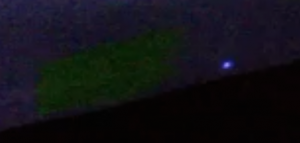
The beam consists of invisible ultraviolet light. To see it you need to place a material that fluoresces in ultraviolet. This is easy to do. Both highlighter ink and white paper will fluoresce in ultraviolet light. Paint a square on your white paper using your highlighter pen or simply place the white paper in the beam line. The above photos show the ultraviolet beam fluorescing green highlighter ink on the left and white paper on the right.
This is a Transversely Excited Atmospheric laser, or a T.E.A. laser. All lasers need a material, or medium, that “lases.” This means that a material, which can be a solid, liquid or gas, is “excited” by some energy such as a high voltage, and has the right properties to allow stimulated emission to produce laser light. It turns out that the lasing material for this laser is nitrogen. Remember that 78% of air is made of nitrogen. It need not be pure nor at some exotic high or low pressure for this to work. We know that the lasing material is nitrogen because the ultraviolet frequency emitted is associated with characteristics of the nitrogen atom.
Here is a video of the laser in operation. Turn your speakers down, the spark flash is loud…
Posted in Journal, Nuclear Fusion Reactor by Mark with comments disabled.
Garage Laser Experiments
Blue Laser in Night Sky
Ok, here are some of my recent laser experiments. Kids, don’t try this at home…
First I went out to the web to see what was the most powerful laser I could purchase for a reasonable price. What I found was someone selling the generator from a laser welder. It was pretty cheap so I bought it. I then bought a used power supply that could deliver 30 amps at 5 volts really cheap at an electronics surplus store. The power supply would deliver up to 60 amps so I built a resistor array that would limit the current to 25 amps and added a push button to turn the power on. The resulting setup is shown in the picture below.
The power supply is the box in the upper left. The laser is the gold box center right with the current limiting resistor array bottom left. Now I wanted to turn it on to see what it could do.
Note the safety goggles in the pic above. These are absolutely required for everyone in the room when this laser is turned on. They must filter the correct frequency of light and be rated in strength according to the laser power. Click here to see this laser in operation. The video shows the laser burning a white cardboard box.
This laser has many dangerous characteristics. Besides the obvious risk of fire, this laser can burn skin. But the greatest hazard is to the eye. The light emitted by this laser is ten thousand times brighter than a laser pointer. You should never look directly at a laser of any power because the eye focuses and magnifies the light on your retina up to 100,000 times. That means a moderately powered laser can instantly burn a hole in the retina causing permanent damage. The injury happens faster than the human blink reflex.
There are a couple more insidious hazards for this kind of laser. First, because it is so bright even a reflection off a matte surface (non-reflective) can cause eye damage. And most dangerous of all, the light is infrared, meaning that it is invisible. A camera is sensitive down in the infrared range so you can see it in the video image, but to the eye it is largely invisible.
It’s a good idea to know what you are doing if you decide to turn on a powerful laser like this. I decided to limit my experiments using this particular laser…
So next I explored what was available in a smaller form factor. When you search these things out, you come up with the popular 445nm blue laser diode used in modern video projectors. There are many hackers who have designed tiny driver boards that allow these diodes to be overdriven to more than 3 watts using a small cell phone battery. What that means is that these lasers can be pushed to run more powerful than they are expected to operate in normal conditions. When the laser is overdriven in this manner, it can easily burn at a distance. So of course I decided to build one. I ordered the parts shown below:
The cylindrical object at the top of the photo is what the laser is mounted in, only about an inch long. The round electronic board at the bottom is a hacker designed charge pump board that delivers the high amperage necessary to overdrive the laser. It’s about the size of a quarter. The laser itself is the small object just to the upper right of the round circuit board.
The small round object in the upper right corner is a glass lens. Normally the laser mount has a plastic lens to focus the beam but because this is an overdriven laser, a glass lens is required so that the lens itself won’t melt.
I got this one put together and tested it (wearing the appropriate safety goggles) and it easily burned stuff at close range. I took a pic of the laser firing at a cardboard box above.
Both of these lasers are the result of high tech manufacturing processes, that is, they are built using semiconductor diodes that did not exist only a few years ago. So perhaps the most interesting laser of all is a home built laser that requires nothing but common material and emits ultraviolet light. I was quite astonished at its simplicity, especially given the difficulties encountered in building the first laser in 1960. In that case it took the intense effort of a corporate research laboratory to develop the first working laser. I wonder how much of history would be different if it was known how easy it was to build a laser like I describe in my next post…
Posted in Nuclear Fusion Reactor, Uncategorized by Mark with comments disabled.
The Fascinating Laser
I’ve always found lasers fascinating, not only as devices but also philosophically. What I mean is this: Natural laser light does not exist in the universe, yet the principle that makes lasers work, called “stimulated emission,” is a fundamental physical property of the universe. Stimulated emission was first predicted by Albert Einstein in 1917, and the first working laser was built in 1960. Actually, the first device built based on stimulated emission was the “maser” first built in the mid-1950s, but it was based on microwaves and not visible light.
The physics and technology to understand and make lasers gets quite complicated. However, all you need to understand from a philosophical perspective is that no laser light existed in the universe before 1960, yet it had always been possible. Humans revealed an obscure physical law of nature and manipulated their environment to make use of it and wow, how useful it has proven to be in science, medicine, consumer electronics, communication. Almost everyone in this country makes use of lasers many times per day without realizing it.
Laser light makes all these things possible. Nature gave the possibility of generating this light, but not the light itself. It took humans to bring that kind of light into existance.
Up next: Laser experiments!
Posted in Journal, Nuclear Fusion Reactor by Mark with comments disabled.
Sailing the Bahamas
Clear Sailing
Just got back from a week sailing in the Bahamas. Overall we had great weather and plenty of wind. The only downside was that we didn’t visit anywhere with good snorkeling, but that was more of a planning issue on our part.
Our 37 foot boat, pictured above, was named “Fun Fun Fun.” I know, I know, but we didn’t name it. It was a one of the newest and most in-shape boats we had ever chartered. On board were Shelly and I plus one of her long-time sailing partners Martha. This trip was much more of a relaxing island cruise than a high seas adventure like last year’s trip to St. Vincent.
We sailed out of Marsh Harbor on Great Abaco, one of the many Bahamian island. We visited several small islands called Cays (pronounced “keys”). All were just north of Abaco, between the island and the Atlantic ocean.
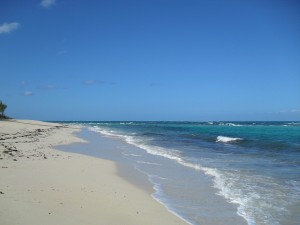
Among them were Great Guana Cay, Manjack Cay, Powell Cay, Spanish Cay and Green Turtle Cay, whose north shore white sands beach is pictured above.
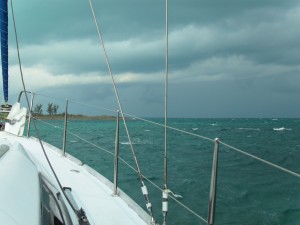
The most difficult passage between islands is going around the north side of Whale Cay where you are more exposed to the swells from the Atlantic. We ran into many veteran sailors who were quite squeamish about crossing this passage in anything but perfect weather. We did it in a storm on our second day, pictured above, and it was very tame in comparison to past experiences. We were flummoxed about what an experienced sailor would be so fearful about. It may get bad at times but I think the reputation of the Whale Cay channel is more bark than bite.
Many may not know that sailing is one of the most civilized adventure activities around. Any excursion worthy of being mentioned as a sailing trip must include happy hour, whether it is a circumnavigation of Antarctica or a Bahamian cruise, as shown above. Kalic is one of the local beers.
Lots of sun and wind. We anchored or docked at a marina every night. Mooring balls were available in most marinas. This was a low tourist time of year so there was never an issue of availability or space. The sun was shining most of the time.
After a swim to check an anchor placement, Shelly was doing her best island girl pose above.
The moon was new, i.e., aligned with the sun, causing larger than average tides. Even the locals were remarking how much tidal change was happening. The above photos show the boat at dock at low and high tides. These pics show the boat in the same location though at slightly different angles. Note the level of the boat deck with respect to the wooden dock. It was difficult to get on and off the boat at either of these extremes.
I did not get to snorkel much at any anchorage. However, this does not mean it doesn’t exist, we just happened to be in some shallow, sandy areas without much to see. We heard about some great nearby places but really didn’t get a chance to visit them on this trip. Overall, it was a fun and very pleasant trip. The locals are very friendly and the area is very well developed.
Finally, just about every night we were treated to a spectacular tropical sunset. It was always something to look forward to:
Posted in Sailing by Mark with 2 comments.
Updates
Hey everyone, well I’ve not been in the wild much lately but I have been obsessively working in the lab. The latest two projects have been particle accelerators and lasers. The nuclear reactor is still in progress as well but I need a couple of critical items that are proving difficult to acquire. In the meantime, progress is being made on other evil projects.
One project is the first step in what I feel will be my ultimate cool experiment, a home made cyclotron. It is a relatively sophisticated particle accelerator that moves subatomic particles along a circular path. It can be done and the equipment requirements are similar to what is needed for a fusion reactor. A first step is to build a linear accelerator that can be built with common parts. I was able to do this and I’ll write about it soon.
The other project has to do with lasers. Wow, I have to say that surprised and impressed at what is available to buy on the internet. I will have an entire category dedicated to these experiments. Like the radiation experiments I have been documenting, these lasers are easy to acquire and extremely dangerous. They won’t kill you but they can certainly cause devastating injuries, namely partial or total blindness.
Fun stuff!
Posted in Uncategorized by Mark with comments disabled.
A Life of Adventure… And, it turns out, danger.
Summit of Denali, 1993
Sunday morning I ran into my friends Ron and Mary Beth at a restaurant. Ron and I discussed the fate of Mark Hesse who recently died in a climbing gym accident here in Boulder. Both Ron and I were remotely connected to Hesse in different ways. Boulder is actually quite a small town. My interaction with Mark was getting his organization to endorse my expedition to Manaslu that happened nearly two decades ago. Hesse had spent much of his 63 years as an adventurer with a focus on climbing, so many were surprised and shocked at what seemed to be a random and almost trivial accident. But should they have been?
I’ve noticed a trend in the last five or so years. A disturbing number of the best climbers and mountaineers that I had known over my climbing career have met with horrific accidents that have either killed or severely injured them. These accidents were from widely varying causes, from equipment failure to avalanches to simple falls down a cliff. What these incidents had in common were that they happened to experts in relatively low to moderately hazardous situations, at least for them. The list is a who’s who of climbers and mountaineers: Todd Skinner, Charlie Fowler, Jack Roberts, and Glenn Porzak to name just a few. Was their lifestyle catching up with them? It made me think about all the times I escaped death in my adventures. Some of it was skill, some luck. I never thought I would die in the mountains, it was just a feeling I had while climbing. But maybe luck runs out.
This kind of incident makes me look back on my life in mountaineering. Here is a list of my big mountain adventures and some interesting notes:
1991: Aconcagua, Argentina, 22,825 ft. First high altitude climb. I was the only person on the upper mountain on December 25. This is the highest mountain outside the Himalayas, and because there was no one climbing high in Asia in the winter, I was the highest person on earth that day.
1993: Denali, Alaska, 20,320 ft. Summitted after only 8 days. Weather was excellent except for the difficult descent section. One of our team fell on a steep section at 17,000 feet and had to later be evacuated by helicopter.
1994: Makalu, Nepal, 27,720 ft. Fifth highest mountain in the world. First Himalayan expedition. Our expedition of 10 members was the only one on the mountain. Very difficult trek to base camp, followed by 8 weeks of living above 17,000 feet. Only two people summitted, including the late great Russian climber Anatoli Boukreev. My high point was 7400 meters. Much of the climbing on this mountain was solo climbing. I was 30 pounds lighter at the end.
1995: I tried to do two back-to-back expeditions over an 8 week timeframe. The first was Mount Logan in Canada where we attempted a difficult ridge route and bailed due to dangerous conditions (it was too warm). Two weeks after returning we flew to Bolivia and climbed Ancohuma, 21,080 ft., our team becoming one of only a handful of Americans to ever have climbed this peak. Main danger was hostile natives. I contracted salmonella poisoning that kept me down for two weeks post-expedition.
1996: Manaslu, Nepal, 26,775 ft. Seventh highest mountain in the world. I organized and led a small team in an attempt to be the first Americans to summit this mountain. Over a three month period we trekked well over 100 miles in monsoon rain through the jungles of Nepal. We reached a high point of around 8000 meters (26,240 ft.), which was the American high point at the time, but could not reach the summit due to both our small team size and a massive storm that dumped more than ten feet of snow, causing a fatality for one of the expeditions on the mountain. Shelly and I came within seconds of being crushed by an ice boulder avalanche. I cracked a rib and experienced a series of tropical illnesses. I performed emergency surgery on a porter who had severely injured his leg. Became separated from our porters in a snowstorm during the initial descent from base camp and survived overnight hypothermia. Witnessed the first signs of the Maoist insurgency in Nepal.
1997: Mount Rainier, Washington. Climbed the Furher Finger route and became lost on the descent in a whiteout snowstorm. I was able to find camp with only an altimeter and “mountain sense,” whatever that means.
1998: I again attempted two back-to-back expeditions to high peaks. The first was back to Denali in Alaska where Shelly and I experience horrific snowstorms and cold weather to minus 40 degrees. Yes it was really that cold, I measured it. Made it to 17,500 feet but could not summit due to hurricane winds that did not abate for a month. Then I flew down to Bolivia and climbed Chearoco, 20,172 feet high. This is a very remote mountain and we claimed the second ascent of the southeast face, breaking trail in two foot deep snow for thousands of feet (read the 1999 American Alpine Journal, page 311).
1999: I led a large well-funded expedition in an attempt to make the first American ascent of Gangapurna in Nepal but gave up early due to the extremely dangerous conditions. Constant rock and icefall due to unseasonably warm temperatures made this a suicide route. One member received a head injury from rockfall.
2000: Mount Logan, Yukon Territory, 19,188 ft. Second attempt, this time on the normal route. Eventually made it to the gargantuan summit plateau at 17,500 feet, staging for an assault on the main summit. High wind and whiteout conditions prevented us from summitting, we had to turn back just below the east summit due to minus 60 degree wind chill and whiteout conditions. Received frostbite on one toe. Fell into a crevasse. Note that as with Denali, we had to fly to the base of the mountain in a small Cessna 185 that uses skids to land on the glacier. The guy who flew us to Logan out of Yakutat, Alaska, was killed two years later when his entire plane broke through into a big crevasse on during takeoff from the glacier while flying out two climbers and their equipment. The climbers survived and had to use their tools to ice climb out of the crevasse. He was the only pilot to fly to Logan and since then no one has replaced him in Yakutat.
2001: Solo expedition to Nepal where I completed a remote trek to climb Mera Peak, 21,221 ft., and Island Peak, 20,300 ft.
2003: Lead a large group to repeat the 2001 expedition and did a fast, solo climb of Mera Peak again Island Peak. Pursued by Maoists for a week through the high country and they never caught us.
2005: Lead an expedition to Peru to climb three high peaks: Pisco, Maparaju and Huapi. Ended up stranded overnight at the base of Pisco on the descent with no food or water.
2007: Again in Peru. Discovered that Huascaran, the crown jewel of the Andes at 22,250 ft., was in rare form and was accessible by the normal route, something that happens only once per decade or two. Summitted in difficult and dangerous avalanche conditions.
Those were just my out-there, remote and unquestionably risky adventures. On top of that I’ve done uncounted Colorado mountains, rock and ice climbing, and hiking in all kinds of weather, all year round.
Maybe I should semi-retire…
Posted in Mountaineering by Mark with comments disabled.
